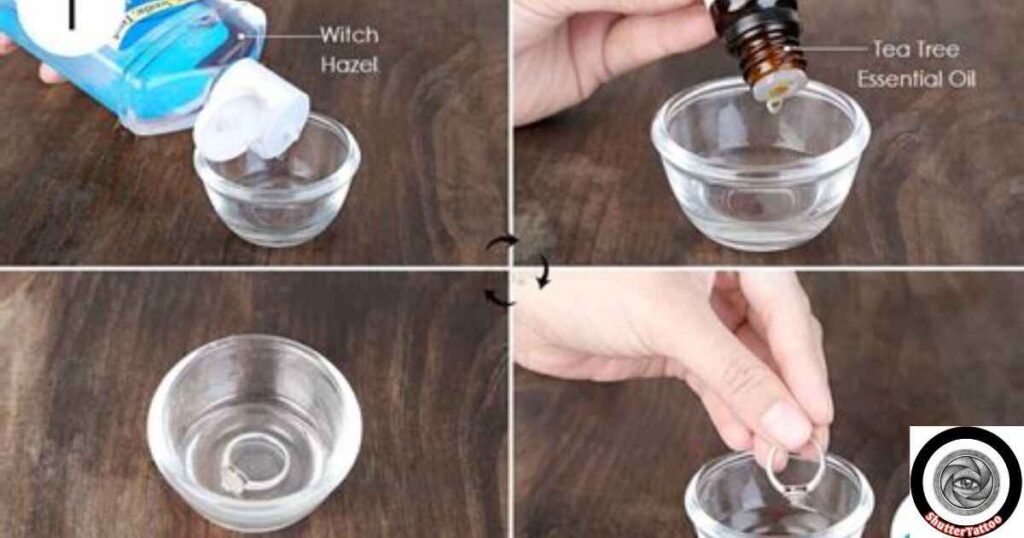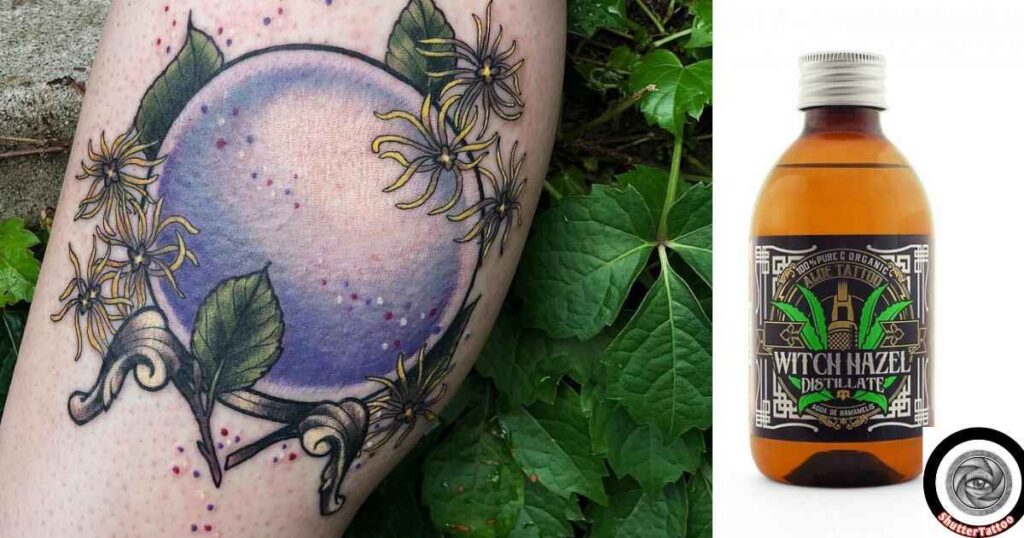Did you know that incorporating witch hazel into your tattoo aftercare routine can significantly enhance healing and vibrancy? This comprehensive guide delves into the benefits, uses, and essential aftercare tips of witch hazel for tattoos. You’ll discover how this natural astringent, renowned for its anti-inflammatory and soothing properties, can aid in reducing redness and swelling, promoting a smoother healing process.
Whether you’re a tattoo enthusiast or a first-timer, understanding the role of witch hazel in tattoo care can make a substantial difference in your skin’s recovery and the longevity of your ink. Read on to explore how to effectively incorporate witch hazel into your tattoo aftercare regimen.
What Is Witch Hazel and Why Is It Great for Tattoos?
Witch hazel, derived from the Hamamelis virginiana shrub, has been a staple in natural skincare for centuries. Its anti-inflammatory and astringent properties make it particularly beneficial for tattoo aftercare. When applied, witch hazel contracts tissues, reducing swelling and redness, which can enhance the healing process of fresh tattoos.
The Natural Healing Power of Witch Hazel

Witch hazel’s natural compounds, including tannins, contribute to its effectiveness in soothing irritated skin. These properties help in calming inflammation and providing relief to freshly tattooed areas, promoting a smoother healing journey.
How Witch Hazel Soothes and Protects Fresh Tattoos
Applying witch hazel to new tattoos can help reduce bleeding and cleanse the area, minimizing the risk of infection. Its gentle nature ensures that the skin remains hydrated without excessive dryness, which is crucial for maintaining the integrity of the tattoo.
Witch Hazel vs. Traditional Tattoo Aftercare Products
Traditional tattoo aftercare often involves petroleum-based ointments or synthetic products. In contrast, witch hazel offers a natural alternative, free from artificial additives. Its astringent properties not only soothe the skin but also tighten it, potentially leading to a more vibrant and well-defined tattoo appearance.
How to Use Witch Hazel for Tattoo Aftercare: A Step-by-Step Guide
Cleaning Your Tattoo with Witch Hazel

- After removing the initial bandage, gently wash the tattooed area with mild, unscented soap and lukewarm water.
- Pat the area dry with a clean paper towel.
- Saturate a fresh paper towel with witch hazel and gently dab it over the tattoo. This helps to soothe irritation and cleanse the area.
Applying Witch Hazel to Reduce Swelling and Redness
- Using a clean cotton pad, apply witch hazel directly to the tattooed area.
- Allow it to air dry. This application can help in reducing swelling and redness, providing comfort during the healing process.
StIncorporating Witch Hazel into Your Daily Aftercare Routine
- Continue to clean the tattoo twice daily using the method described in Step 1.
- After each cleaning, apply a thin layer of a mild, unscented moisturizer to prevent dryness.
- Whenever the tattoo feels itchy or dry, gently apply witch hazel to soothe the area before moisturizing.
The Top 5 Benefits of Using Witch Hazel on Tattoos
Incorporating witch hazel into your tattoo aftercare routine offers several benefits that can enhance healing and maintain the vibrancy of your ink.
Reduces Inflammation and Soothes Irritated Skin
Witch hazel’s natural astringent properties help contract tissues, effectively reducing inflammation and soothing irritated skin. This can alleviate discomfort and promote a calmer healing environment for your new tattoo.
Prevents Infection with Natural Antiseptic Properties
The antiseptic qualities of witch hazel assist in cleansing the tattooed area, minimizing the risk of bacterial infections. By keeping the skin clean, it supports a healthier healing process.
Speeds Up the Healing Process for Vibrant Tattoos

By reducing swelling and maintaining skin cleanliness, witch hazel contributes to a more efficient healing process. This can result in a more vibrant and well-defined tattoo appearance.
Minimizes Scabbing and Peeling for Smoother Results
Regular application of witch hazel can help minimize scabbing and peeling, leading to a smoother healing experience. This ensures that the tattoo heals evenly, preserving the quality of the design.
Safe for All Skin Types, Including Sensitive Skin
Witch hazel is generally well-tolerated and suitable for various skin types, including sensitive skin. Its gentle nature makes it an excellent choice for those seeking a natural aftercare solution.
Common Questions About Witch Hazel and Tattoos Answered
Witch hazel has become a popular component in tattoo aftercare, but many enthusiasts have questions about its application and safety. Additionally, crafting DIY aftercare solutions can offer personalized care for your new ink. Let’s delve into common inquiries and explore some simple recipes.
Can You Use Witch Hazel on New Tattoos?
Yes, witch hazel can be applied to new tattoos. Its natural astringent and anti-inflammatory properties help reduce redness and swelling, promoting a smoother healing process. However, it’s essential to use alcohol-free and unscented witch hazel to prevent irritation.
Is Witch Hazel Safe for Color and Black-and-Grey Tattoos?
Absolutely. Witch hazel is safe for both color and black-and-grey tattoos. It aids in soothing the skin without affecting the vibrancy or integrity of the ink. Many artists use it during the tattooing process to clean the area and reduce bleeding.
How Often Should You Apply Witch Hazel to a Healing Tattoo?
Applying witch hazel 2-3 times daily during the initial healing phase is recommended. Always ensure your hands are clean before application to prevent infection. Monitor your skin’s response and adjust usage if any irritation occurs.
Can Witch Hazel Fade Tattoos? Debunking the Myths
No, witch hazel does not cause tattoo fading. When used appropriately, it can actually enhance the healing process, preserving the tattoo’s appearance. It’s crucial to use products free from harsh chemicals that might affect your tattoo’s longevity.
DIY Witch Hazel Aftercare Recipes for Tattoo Lovers
Simple Witch Hazel and Aloe Vera Soothing Spray
Ingredients:
- 1/2 cup distilled water
- 1/4 cup alcohol-free witch hazel
- 1/4 cup pure aloe vera gel
- 5 drops of lavender essential oil (optional)
Instructions:
- Combine all ingredients in a spray bottle.
- Shake well before each use.
- Lightly mist over the tattooed area 2-3 times daily to soothe and hydrate the skin.
Witch Hazel and Coconut Oil Moisturizing Balm
Ingredients:
- 2 tablespoons coconut oil
- 1 tablespoon shea butter
- 1 tablespoon beeswax pellets
- 1 tablespoon witch hazel
- 5 drops of tea tree essential oil (optional)
Instructions:
- In a double boiler, melt the coconut oil, shea butter, and beeswax together.
- Remove from heat and stir in the witch hazel and tea tree oil.
- Pour the mixture into a small container and let it solidify.
- Apply a thin layer to the tattooed area as needed to keep the skin moisturized.
Cooling Witch Hazel and Green Tea Compress for Swelling
Ingredients:
- 1 cup brewed green tea, cooled
- 1/2 cup witch hazel
- Soft cloth or gauze
Instructions:
- Mix the cooled green tea and witch hazel in a bowl.
- Soak the cloth or gauze in the solution and wring out excess liquid.
- Gently place the compress over the tattooed area for 10-15 minutes to reduce swelling and provide relief.
Expert Tips for Maximizing the Benefits of Witch Hazel on Tattoos
Integrating witch hazel into your tattoo aftercare routine can significantly enhance healing and maintain the vibrancy of your ink. To maximize its benefits, consider the following expert tips:
Choosing the Right Witch Hazel Product for Your Tattoo

Opt for alcohol-free and unscented witch hazel to prevent skin irritation. Not all witch hazel products are created equal. Selecting an alcohol-free and unscented variant ensures gentle care for your healing tattoo. Products containing alcohol can dry out the skin, potentially hindering the healing process. For instance, some tattoo aftercare routines recommend spritzing the area with witch hazel and allowing it to air dry, emphasizing the importance of gentle application.
Pairing Witch Hazel with Other Natural Aftercare Ingredients
Combine witch hazel with natural moisturizers like aloe vera or coconut oil for enhanced soothing effects. Witch hazel’s anti-inflammatory properties can be complemented by other natural ingredients to promote optimal healing:
- Aloe Vera: Known for its cooling and moisturizing effects, aloe vera can soothe irritated skin when applied alongside witch hazel.
- Coconut Oil: This natural moisturizer helps maintain skin hydration, reducing dryness and peeling.
When to Avoid Witch Hazel and Consult Your Tattoo Artist
Actionable Takeaway: If you experience excessive redness, swelling, or prolonged irritation, discontinue use and consult your tattoo artist or a dermatologist.
While witch hazel is generally safe, it’s crucial to monitor your skin’s reaction:
- Signs to Watch For: Increased redness, swelling, itching, or any signs of infection.
- Immediate Actions: Stop using witch hazel and consult your tattoo artist or a healthcare professional for guidance.
Real-Life Experiences: Tattoo Artists and Enthusiasts Share Their Witch Hazel Stories
For instance, some aftercare instructions advise that if you feel any irritation, discomfort, or develop any kind of reaction to the bandage, you should remove it immediately, as sensitivities may occur.
Read This Blog: Mastering Tattoo Voltage for Lining and Shading: The Ultimate Guide
Why Tattoo Artists Recommend Witch Hazel for Aftercare
Actionable Takeaway: Understand that many tattoo artists incorporate witch hazel into their process to reduce redness and soothe the skin.
Tattoo artists often utilize witch hazel during and after the tattooing process:
- During Tattooing: Witch hazel can be used to clean the area, reduce bleeding, and soothe the skin.
- After Tattooing: It helps in calming the skin, reducing redness, and preparing the area for healing.
Customer Reviews: How Witch Hazel Transformed Their Tattoo Healing Process
Consider incorporating witch hazel into your aftercare routine based on positive experiences from others.
Many individuals have reported improved healing experiences when using witch hazel:
- Reduced Irritation: Users have noted decreased redness and swelling.
- Enhanced Comfort: Some have found that witch hazel provides a soothing sensation, making the healing process more comfortable.
Before and After: The Visible Impact of Witch Hazel on Tattoos
Observe the potential benefits of witch hazel through before-and-after comparisons.
Visual evidence highlights witch hazel’s positive effects on tattoo healing:
- Before: Tattoos may exhibit redness, swelling, and irritation.
- After: With proper use of witch hazel, many notice reduced inflammation and a more vibrant appearance.
Conclusion
Incorporating witch hazel into your tattoo aftercare routine can significantly enhance healing and maintain the vibrancy of your ink. Its natural properties help reduce inflammation, prevent infection, and soothe irritated skin. By choosing the right witch hazel product and pairing it with other natural ingredients, you can optimize your tattoo’s healing process.
Many tattoo artists and enthusiasts have shared positive experiences, highlighting witch hazel’s effectiveness in aftercare. Ready to experience these benefits for yourself? Share your thoughts or questions in the comments below, and explore our related articles to further enhance your tattoo care knowledge.

